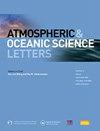Interannual variability of short rains in Tanzania and the influences from ENSO and the Indian Ocean Dipole
IF 3.2
4区 地球科学
Q3 METEOROLOGY & ATMOSPHERIC SCIENCES
引用次数: 0
Abstract
Tanzania is mainly subject to a bimodal rainfall pattern, characterized by two distinct seasons: the long rains, occurring from March to May, and the short rains, which typically take place from October to December (OND). Short rains are usually less intense but still significantly influence local agriculture. Therefore, with station-based observations and reanalysis data, the current paper examines the interannual variability of OND precipitation in Tanzania from 1993 to 2022 and explores the possible impacts from El Niño–Southern Oscillation (ENSO) and the Indian Ocean Dipole (IOD) as well as the mechanisms. It is found that the Tanzania OND precipitation is above (below) normal in 1997, 2006, 2011, and 2019 (1993, 1998, 2005, and 2016). The composite difference between wet (dry) years and the climatology indicates that the anomalous lower-level convergence (divergence) and upward (downward) motion are the critical circulation characters for above (below) precipitation. Further analysis indicates ENSO and the IOD are the two main oceanic systems modulating OND precipitation in Tanzania. El Niño and a positive IOD could induce easterly anomalies and weaken the Walker circulation over the Indian Ocean, consequently leading to lower-level convergence in water vapor flux, upward anomalies, and more than normal precipitation in Tanzania. In contrast, La Niña and a negative IOD produce opposite circulation anomalies and less than normal precipitation over Tanzania. Moreover, through partial correlation and Generalized Equilibrium Feedback Analysis, the individual contributions of ENSO and the IOD to circulation are investigated. It is found that although both the IOD and ENSO impact the Walker circulation, the feedback to the IOD is stronger than ENSO. These results provide critical insights into the oceanic drivers and their mechanistic pathways underlying precipitation anomalies in Tanzania.
摘要
坦桑尼亚降水模态呈现双峰型, 其显著特征为两个不同的雨季: 长雨季 (3月至5月) 和短雨季 (10月至12月 (OND)). 短雨季降水强度通常较弱, 但对当地农业仍具有重要影响. 基于站点观测和再分析数据, 本文研究了1993–2022年坦桑尼亚OND降水的年际变化特征, 并探讨了厄尔尼诺-南方涛动 (ENSO) 和印度洋偶极子 (IOD) 的可能影响及其机制. 研究发现, 坦桑尼亚OND降水在1997, 2006, 2011和2019年偏多 (1993, 1998, 2005和2016年偏少) . 降水偏多 (偏少) 年与气候态之间的差值场合成分析表明, 异常低层辐合 (辐散) 和上升 (下沉) 运动是降水偏多 (偏少) 的关键环流特征. 进一步分析发现, ENSO和IOD是调控坦桑尼亚OND降水年际变化的主要海洋系统. 厄尔尼诺事件和正位相IOD会引发印度洋低层东风异常并削弱其上空Walker环流, 从而导致坦桑尼亚水汽通量在低层辐合, 上升运动异常和降水增多. 相反, 拉尼娜事件和负位相IOD会引起相反的环流异常, 导致该地区降水减少. 通过偏相关分析和广义平衡反馈方法, 本文量化了ENSO和IOD对环流的独立贡献. 结果表明, 虽然IOD和ENSO均会影响Walker环流, 但IOD的作用强于ENSO. 这些发现为理解坦桑尼亚降水异常的海洋驱动因子及其机理路径提供了重要科学依据.
坦桑尼亚短雨的年际变化及ENSO和印度洋偶极子的影响
坦桑尼亚主要属于双峰降雨模式,其特点是两个不同的季节:长雨,发生在3月至5月,短雨,通常发生在10月至12月(OND)。短时降雨通常强度较小,但仍对当地农业产生重大影响。因此,本文利用台站观测和再分析资料,分析了1993 - 2022年坦桑尼亚OND降水的年际变化,探讨了El Niño-Southern涛动(ENSO)和印度洋偶极子(IOD)可能对其产生的影响及其机制。结果表明,1997年、2006年、2011年和2019年(1993年、1998年、2005年和2016年)坦桑尼亚OND降水均高于(低于)正常值。湿(干)年和气候学的综合差值表明,异常的低层辐合(辐散)和上升(下降)运动是上(下)降水的关键环流特征。进一步分析表明ENSO和IOD是调节坦桑尼亚OND降水的两个主要海洋系统。El Niño和正IOD会引起偏东异常并减弱印度洋上的Walker环流,从而导致水汽通量的低层辐合、上升异常以及坦桑尼亚的降水多于正常。相反,La Niña和负IOD在坦桑尼亚上空产生相反的环流异常和低于正常的降水。此外,通过偏相关分析和广义平衡反馈分析,探讨了ENSO和IOD对环流的各自贡献。研究发现,虽然IOD和ENSO都对Walker环流有影响,但对IOD的反馈强于ENSO。这些结果为了解坦桑尼亚降水异常背后的海洋驱动因素及其机制途径提供了重要见解。摘要坦桑尼亚降水模态呈现双峰型,其显著特征为两个不同的雨季:长雨季(3月至5月)和短雨季(10月至12月(的生命)。短雨季降水强度通常较弱, 但对当地农业仍具有重要影响. 基于站点观测和再分析数据,本文研究了1993 - 2022年坦桑尼亚的生命降水的年际变化特征,并探讨了厄尔尼诺——南方涛动(ENSO)和印度洋偶极子(IOD)的可能影响及其机制。研究发现,坦桑尼亚的生命降水在1997,2006,2011和2019年偏多(1993、1998、2005和2016年偏少)。降水偏多 (偏少) 年与气候态之间的差值场合成分析表明, 异常低层辐合 (辐散) 和上升 (下沉) 运动是降水偏多 (偏少) 的关键环流特征. “”“”“”“”厄尔尼诺事件和正位相IOD会引发印度洋低层东风异常并削弱其上环空沃克流,从而导致坦桑尼亚水汽通量在低层辐合,上升运动异常和降水增多。这句话的意思是:“我的意思是,我的意思是,我的意思是,我的意思是。”英文:http://jin齐泽涛,齐泽涛,齐泽涛,齐泽涛。这些发现为理解坦桑尼亚降水异常的海洋驱动因子及其机理路径提供了重要科学依据.
本文章由计算机程序翻译,如有差异,请以英文原文为准。
求助全文
约1分钟内获得全文
求助全文
来源期刊

Atmospheric and Oceanic Science Letters
METEOROLOGY & ATMOSPHERIC SCIENCES-
CiteScore
4.20
自引率
8.70%
发文量
925
审稿时长
12 weeks
 求助内容:
求助内容: 应助结果提醒方式:
应助结果提醒方式:


